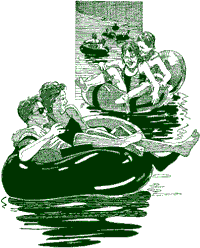Subject Areas
Science, Social Studies, Mathematics
Duration
Several class periods of 45 minutes each
Setting
Outdoors — along the edge of the Maurice River (or nearby stream, creek, etc.)
Skills
Map skills, data collection and interpretation, use of scientific instruments, measuring,implementation of the scientific process
Charting the Course
The importance of rivers and wetlands to the region called "Down Jersey" cannot be overemphasized. Almost everything shown in the film somehow relates back to water. The integrity  and quality of the aquatic systems are critical to sustaining the region and the livelihood of its inhabitants. and quality of the aquatic systems are critical to sustaining the region and the livelihood of its inhabitants.
Vocabulary
Erosion, turbidity, pH, dissolved oxygen, phosphates, nitrates, current, flow, tide, runoff, nonpoint source pollution
Correlation to NJ Core Curriculum Content Standards
Science: 5.1 (1,4,5), 5.2 (1,2,3,4,5,6,9,10), 5.5 (1,2,3,4,5,9), 5.12 (1,2,3,4,5,6,7)
Social Studies: 6.7 (5,8), 6.8 (3), 6.9 (2,3,5,7,8)
Mathematics: 4.1 (1,2,4,5,6,7,8,9), 4.2 (1,2,4,6,8,9), 4.3 (2,3,4,6,7), 4.4 (1,2,4,10), 4.5 (1,2,4), 4.7 (1,10), 4.9 (1,5), 4.11 (4,9), 4.12 (1,2,3,5)
|
Objectives
Students will be able to:
- Understand the location, direction of flow, and origin of the river.
- Develop mathematical skills in determining the width of the river.
- Discover how erosion of soil is caused by water.
- Know about and discover impurities in the Maurice River.
- Understand purification methods.
Materials
Water testing equipment: thermometers, secci disk, pH paper or kit, measuring tape and meter stick
Making Connections
Background information should be discussed.
Discuss evidence that man uses the water/the river for transportation.
 Evidence that man uses the Maurice River as a place to live. Evidence that man uses the Maurice River as a place to live.
Evidence that the presence of the Maurice River affects the economic life of the communities that it touches.
Evidence that man is able to control the water level.
Is the use of the body of water by man resulting in pollution or contamination?
Background
The film Down Jersey provides insight into the importance of rivers to the region.
Historic Themes and Resources (link to HIstoric Themes and Resources) book. Most of the book relates in some way to the rivers and the bay.
Chapter 1. (link) Introduction — page 3
Chapter 2. (link) Urban Development (sections as related to settlement along the river)
Chapter 3. (link) Maritime Activity
Chapter 6. (link) Transportation
General information on water, rivers, watersheds, erosion, etc.
Procedure
Warm Up
While watching the film Down Jersey, have students record/count the number of times that water is shown. Use this as a springboard to discuss the uses and importance of rivers to the area.
Prior to the Field Trip Discuss:
- Which direction does the river flow?
- Where is the origin of the river?
- Where does the river empty? What cities does it pass through?
- Locate the Maurice River on a map. Find other important bodies of water, cities, and other points of reference.
The Activity
Take a field trip to the Maurice River (or other body of water.)
During the Field Trip:
- Determine the width of the river by using the Angle method.
- Determine/calculate the velocity or rate of flow of the water.
- Use a thermometer to find the temperature of the water in the river and compare it with the air temperature.
- Look for evidence which indicates that water causes the soil to erode and carries it from one place to another.
- Observe and describe:
 Color of the water Color of the water
- Plants along the banks
- Bottom or bed of the river
- Materials or scum on the surface
- Signs of animal life
- Signs of human activity
- Ask yourself: “What factors might be found in, on, or below this body of water?”
Observational aides:
- Turbidity: Secci disk, settling test
- Temperature: measure at various depths
- pH: use a piece of test tape
- Hardness: the soap test —compare to water from other sources
- Dissolved oxygen: what is the meaning?
- Depth: does it vary? Daily? Seasonally/Based on storm events?
Wrap Up
What does this all mean? List the factors observed under the appropriate category: abiotic or biotic. Which of the biotic factors are producers, consumers, and decomposers?
Draw lines connecting the factors that are related or interdependent.
Which of these lines are based upon fact? Which are hypotheses? Which can be checked by going to authorities and/or reference materials? Which can be checked by direct observation and experiment?
Action
Organize a stream/river cleanup along a particularly littered section and/or one that is convenient to your school property.
Storm drain stenciling is one effective way to show the interconnectedness of the river to the bay. By placing a symbol (a crab or a fish) from the bay on the storm drain, the message becomes clear that "The Bay Starts Here" and that everything that gets washed into the storm drain will eventually end up in the Delaware Bay.
Contact: Colleen Thomas, NJDEP, at (609) 633-3855 for more information about how to start a storm drain stenciling project in your community.
Assessment
Students can be asked to give an oral, written, or photographic/video report on the field trip findings.
Extensions
Students investigate more than one section of the river — or more than one river — and compare/contrast them.
Students research the national "Wild and Scenic River" program.
Please download the PDF for a complete lesson plan.
| Resources
There are a multitude of resources available that are related to the topic of rivers, watersheds, water quality and testing, and animals/plants of the river environment. Check for a local watershed group or water treatment facility that may be able to provide some information.
GREEN (Global Rivers Environmental Education Network) has an online News Service for watershed education and action. It includes news bulletins and announcments that are available each week.To subscribe to gr-announce send the following message to [email protected]: subscribe gr-announce. This is a FREE service.
Visit the GREEN website at http://www.econet.apc.org/green/riverbank |
|


 and quality of the aquatic systems are critical to sustaining the region and the livelihood of its inhabitants.
and quality of the aquatic systems are critical to sustaining the region and the livelihood of its inhabitants. Evidence that man uses the Maurice River as a place to live.
Evidence that man uses the Maurice River as a place to live. Color of the water
Color of the water